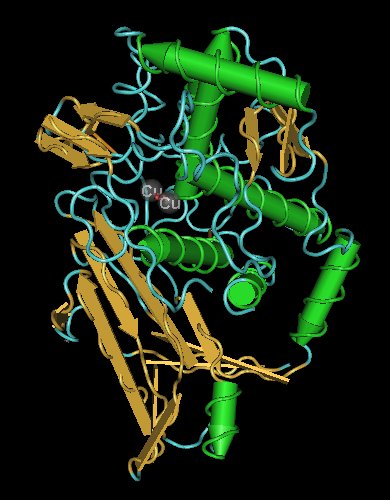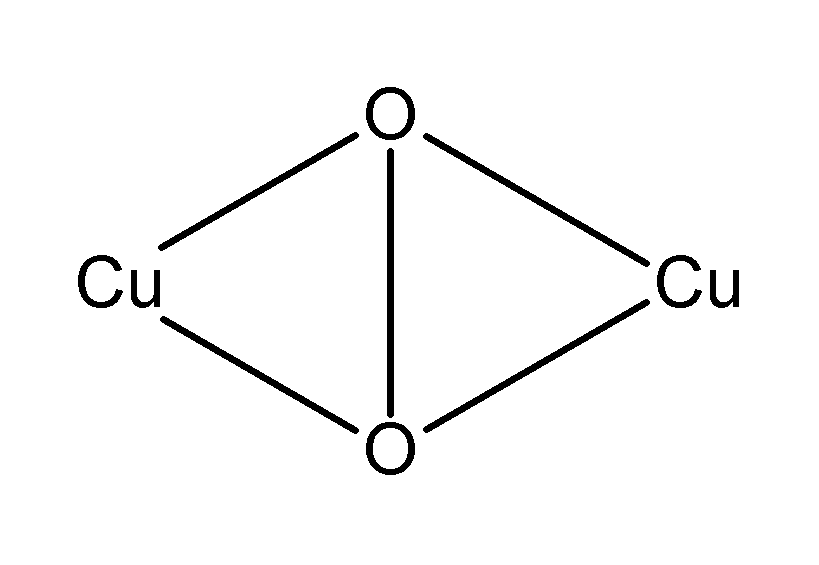Hemocyanin

| Cardiology Network |
 Discuss Hemocyanin further in the WikiDoc Cardiology Network |
| Adult Congenital |
|---|
| Biomarkers |
| Cardiac Rehabilitation |
| Congestive Heart Failure |
| CT Angiography |
| Echocardiography |
| Electrophysiology |
| Cardiology General |
| Genetics |
| Health Economics |
| Hypertension |
| Interventional Cardiology |
| MRI |
| Nuclear Cardiology |
| Peripheral Arterial Disease |
| Prevention |
| Public Policy |
| Pulmonary Embolism |
| Stable Angina |
| Valvular Heart Disease |
| Vascular Medicine |
Template:WikiDoc Cardiology News Editor-In-Chief: C. Michael Gibson, M.S., M.D. [1]
Hemocyanins (also spelled haemocyanins) are respiratory proteins in the form of metalloproteins containing two copper atoms that reversibly bind a single oxygen molecule (O2). Oxygenation causes a color change between the colorless Cu(I) deoxygenated form and the blue Cu(II) oxygenated form. Hemocyanins carry oxygen in the blood of most molluscs, and some arthropods such as the horseshoe crab. They are second only to hemoglobin in biological popularity of use in oxygen transport.
Explanation
Although the respiratory function of hemocyanin is similar to that of hemoglobin, there are a significant number of differences in its molecular structure and mechanism. Whereas hemoglobin carries its iron atoms in porphyrin rings (heme groups), the copper atoms of hemocyanin are bound as prosthetic groups coordinated by histidine residues. Species using hemocyanin for oxygen transportation are commonly crustaceans living in cold environments with low oxygen pressure. Under these circumstances hemoglobin oxygen transportation is less efficient than hemocyanin oxygen transportation.
Most hemocyanins bind with oxygen non-cooperatively and are roughly one-fourth as efficient as hemoglobin at transporting oxygen per amount of blood. Hemoglobin binds oxygen cooperatively due to steric conformation changes in the protein complex, which increases hemoglobin's affinity for oxygen when partially oxygenated. In some hemocyanins of horseshoe crabs and some other species of arthropods, cooperative binding is observed, with Hill coefficients between 1.6-3. Hill constants vary depending on species and laboratory measurement settings. Hemoglobin for comparison has a Hill coefficient of usually 2.8-3. In these cases of cooperative binding hemocyanin was arranged in protein sub-complexes of 6 subunits (hexamer) each with one oxygen binding site, binding of oxygen on one unit in the complex would increase the affinity of the neighboring units. Each hexamer complex was arranged together to form a larger complex of dozens of hexamers. In one study, cooperative binding was found to be dependent on hexamers being arranged together in the larger complex, suggesting cooperative binding between hexamers. Hemocyanin oxygen-binding profile is also affected by dissolve-salt ion levels and pH.
Hemocyanin is made of many individual subunit proteins, each of which contains two copper atoms and can bind one oxygen molecule (O2). Each subunit weighs about 75 kilodaltons (kDa). Subunits may be arranged in dimers or hexamers depending on species, the dimer or hexamer complex is likewise arranged in chains or clusters in weights exceeding 1500 kDa. The subunits are usually homogeneous, or heterogeneous with two variant subunit types. Because of the large size of hemocyanin, it is usually found free-floating in the blood, unlike hemoglobin, which must be contained in cells because its small size would lead it to clog and damage blood-filtering organs such as the kidneys. This free-floating nature can allow for increased hemocyanin density over hemoglobin and increased oxygen carrying capacity. On the other hand, free-floating hemocyanin can increase viscosity and increase the energy expenditure needed to pump blood.
Structure

Spectroscopy of oxyhemocyanin shows several salient features:
- resonance Raman spectroscopy shows symmetric binding
- UV-Vis spectroscopy shows strong absorbances at 350 and 580 nm.
- OxyHc is EPR-silent indicating the absence of unpaired electrons
- Infrared spectroscopy shows ν(O-O) of 755 cm-1
(1) rules out a mononuclear peroxo complex (2) does not match with the UV-Vis spectra of mononuclear peroxo and Kenneth Karlin's trans-peroxo models.[1] (4) shows a considerably weaker O-O bond compared with Karlin's trans-peroxo model.[1]
On the other hand, Nobumasa Kitajima's model shows ν(O-O) of 741 cm-1 and UV-Vis absorbances at 349 and 551 nm, which agree with the experimental observations for oxyHc.[2]
The weak O-O bond of oxyhemocyanin is because of metal-ligand backdonation into the σ* orbitals. The donation of electrons into the O-O antibonding orbitals weakens the O-O bond, giving a lower than expected infrared stretching frequency.
See also
References
- ↑ 1.0 1.1 K. D. Karlin, R. W. Cruse, Y. Gultneh, A. Farooq, J. C. Hayes and J. Zubieta (1987). "Dioxygen-copper reactivity. Reversible binding of O2 and CO to a phenoxo-bridged dicopper(I) complex". J. Am. Chem. Soc. 109 (9): 2668–2679. doi:10.1021/ja00243a019.
- ↑ N. Kitajima, K. Fujisawa, C. Fujimoto, Y. Morooka, S. Hashimoto, T. Kitagawa, K. Toriumi, K. Tatsumi and A. Nakamura (1992). "A new model for dioxygen binding in hemocyanin. Synthesis, characterization, and molecular structure of the μ-η2:η2 peroxo dinuclear copper(II) complexes, [Cu(HB(3,5-R2pz)3)]2(O2) (R = isopropyl and Ph)". J. Am. Chem. Soc. 114 (4): 1277–1291. doi:10.1021/ja00030a025.